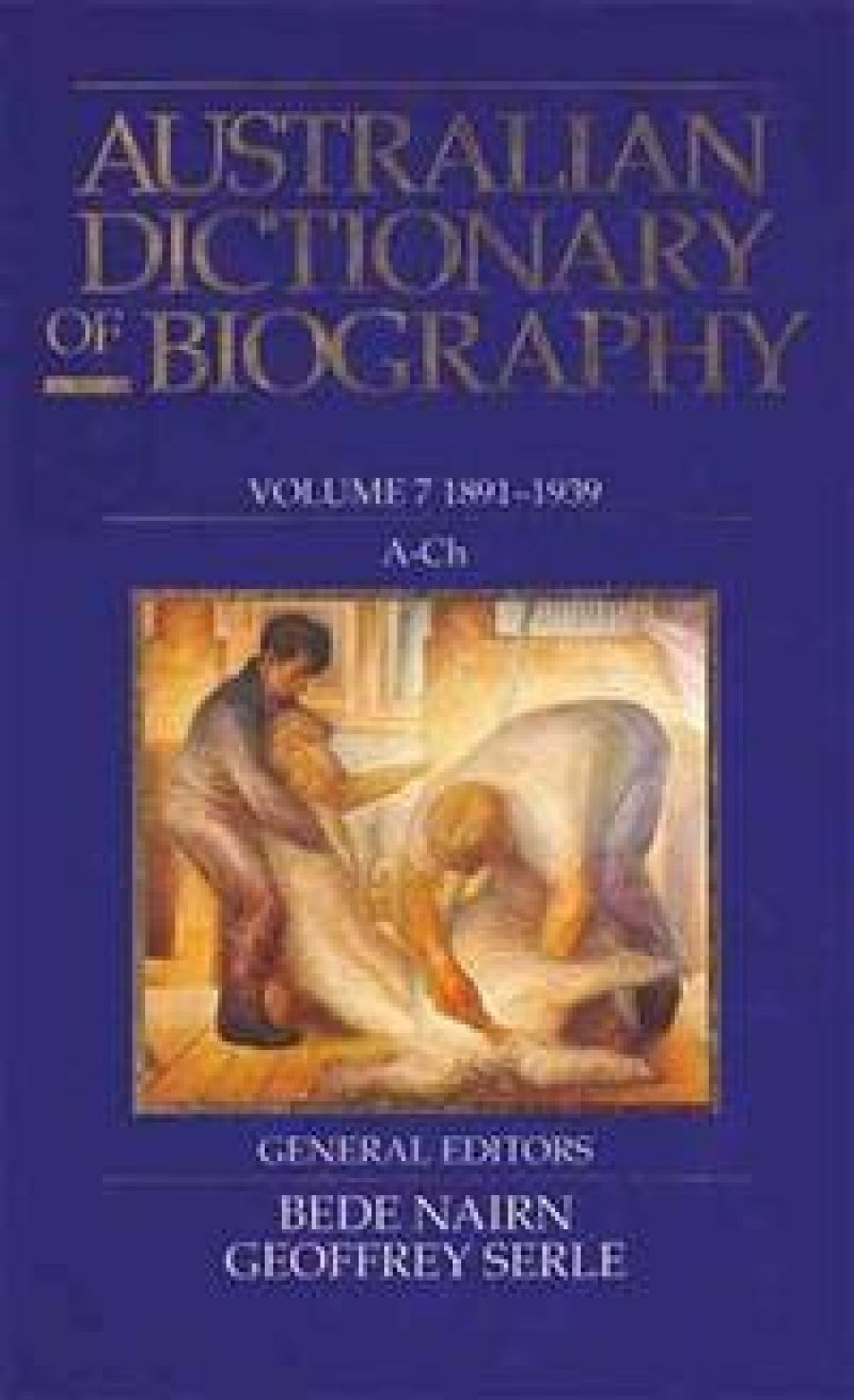
- Free Article: No
- Contents Category: Biography
- Review Article: Yes
- Article Title: Everything But the Warts
- Online Only: No
- Custom Highlight Text: In his uncommonly long life, Mahomet Allum, a native of Afghanistan, combined the vocations of camel driving, herbalism and philanthropy – not in Kabul, but in Adelaide. Allum believed himself ‘God’s messenger’, but a Crown Prosecutor described him as a particularly deceitful and cunning ‘quack’ and brought about his conviction under the Medical Practitioners Act.
- Book 1 Title: The Australian Dictionary of Biography Vol 7 1891–1939, A–Ch
- Book 1 Biblio: Melbourne University Press, 647 pp, $25.00
The soldier, Chauvel, gets more attention than the socialist Childe, which doubtless suggests a pro-soldiering rather than an antisocialist bias. In any case, there seem to have been more soldiers. The Donald Camerons of the day are good examples: there are four of them in this volume and, while each was at some stage a soldier, only Donald James was also a socialist. There may be too much emphasis on the military side of things for some people’s taste and the soldiering entries do seem to be the most laudatory and the least critical, but a dictionary of people’s lives in this period could suggest nothing if not the pervasiveness of war.
There are some notable capitalists, especially W.L. Baillieu, whose father, James, set foot in Australia only after a two-mile swim from a boat anchored inside the heads of Port Phillip Bay. The mine owner John Brown – perhaps the arch-fiend of Australian capitalism – rates a long entry. Brown left nearly £150,000 to (Sir) Edward Warren, which was considerably more than that left by the miner, Norman Brown, who was shot dead by police in 1929 during a lock-out in which John Brown played a leading part. Norman, of course, is not mentioned in the ADB.
On the other hand, there are some of Labor’s more remarkable, and even more tragic figures. Frank Anstey, Maurice Blackburn, Frank Brennan, and Henry Boote all began their political careers believing that the dawn of reason was about to break and died in the sure knowledge that it was as far away as ever. With the war, the split in the ALP and, equally, the Russian Revolution, 1917 was as important a date as any in Australian history, and the ADB makes this abundantly clear.
We have, in addition, the poet–philosophers Christopher Brennan and William Baylebridge; the war historian and Anzac legender, C.E.W. Bean; the musical pair Florence Austral and John Amadio; the great soldier, Birdwood; Stanley Melbourne Bruce who became prime minister and Senator Cleaver Bunton's brother, Haydn, who won three Brownlow Medals.
In general, the ADB manages to be both an invaluable reference work and a good read, and any criticism of it is likely to appear to be of the nit-picking – if not blasphemous – variety. But the ADB should be no more immune to problems of selection and emphasis than any other work in the humanities. In fact, the Dictionary faces a fundamental difficulty in this regard; for while by name it is objective, it is by nature subjective. The editors wisely decided in the beginning that more than the stark facts of a person’s procession from cradle to grave were necessary to constitute a biographical dictionary, and so they allowed contributors room for a more detailed, contextual and interpretive treatment of their subjects. This policy, however fraught with irresolvable problems for both writer and editor, made the Dictionary a vastly more useful and entertaining work than a mere register would have been: but it is therefore all the more irritating to sense that a uniformly bland editorial style is imposed on the writing, presumably to enhance the ‘objectivity’ of the final product.
Whatever the intention, the result is a sense that a Pangloss has been at work. The writing often lacks bite, the subjects lack warts – they glide effortlessly to their destinies and the assessment of probate.
The ADB, of course, cannot be definitive. People with special knowledge will inevitably find entries containing both dubious interpretations and errors of fact. Equally, in time we will find that people who deserve to be included have not been: there are bound to be more women and more Aboriginals as new research uncovers more of their history.
The problem for the ADB is to do justice to the lives without becoming a source of historical mythmaking. It might be wiser, then, to acknowledge the difficulties and contradictions the Dictionary faces and let contributors have a freer hand. In this case we might be told what the mechanics of William Chidley’s sexual theory were, we might see what Stanley Melbourne Bruce failed to do, and even the soldiers might make a mistake from time to time.
Yet this approach might well be unmanageable and one criticises respectfully. The Dictionary demands that one forget the basic contradiction in the whole concept. Now that is not so hard as it may seem, especially when one is looking for shortcuts. In any event, the Australian Dictionary of Biography is one of the few great cooperative achievements of the humanities in Australia, and this volume is worth a glance just to discover that Johannes Bjelke Peterson’s Aunt Marie posted letters to fairies in her garden!


Comments powered by CComment